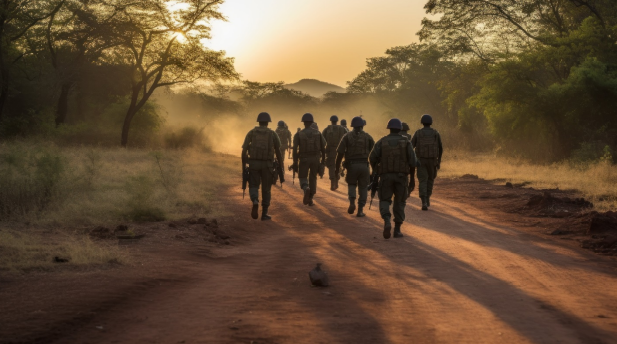The sprawling savannahs of Africa, with their golden grasses and majestic wildlife, present a serene picture of nature at its finest. However, beneath this picturesque landscape lies a fierce battle—a battle to protect the very creatures that make these ecosystems unique. At the forefront of this fight are the anti-poaching units, dedicated teams whose efforts are crucial in safeguarding wildlife from the relentless threat of poachers. Stephen Wentzel delves into the indispensable role of anti-poaching units, the challenges they face, and their unwavering commitment to preserving biodiversity.
The Imperative of Anti-Poaching Efforts
Poaching, the illegal hunting and capturing of wild animals, has long been a blight on Africa’s natural heritage. Driven by the lucrative trade in animal parts—such as elephant tusks, rhino horns, and pangolin scales—poachers exploit the continent’s rich biodiversity at the cost of pushing many species toward extinction. The illegal wildlife trade is estimated to be worth billions of dollars annually, making it one of the most profitable illicit activities worldwide, second only to drugs and arms trafficking.
Anti-poaching units are essential in combating this scourge. These teams, often comprised of rangers, local community members, and sometimes military personnel, operate in some of the most challenging environments. Their mission is to protect endangered species and maintain the balance of ecosystems that are vital for the health of the planet.
The Structure and Strategies of Anti-Poaching Units
Anti-poaching units operate through a combination of surveillance, patrolling, and community engagement. Modern technology plays a significant role in enhancing their effectiveness. The use of drones, GPS tracking, and camera traps allows for better monitoring of wildlife and early detection of poaching activities. In addition to technological advancements, traditional methods such as foot patrols and intelligence gathering remain critical components of anti-poaching strategies.
- Surveillance and Monitoring: Anti-poaching units employ advanced surveillance techniques to monitor vast areas. Drones equipped with night-vision cameras provide aerial views, enabling rangers to cover large territories and spot potential threats. GPS tracking collars on key species help track their movements and alert teams to unusual patterns that might indicate poaching activities.
- Patrolling and Enforcement: Regular patrols by rangers are essential for deterring poachers and responding to threats. These patrols can be grueling, often requiring rangers to navigate difficult terrain and endure harsh weather conditions. The presence of armed rangers acts as a deterrent to poachers, who risk arrest or engagement in confrontations.
- Community Involvement: Engaging local communities is crucial for the success of anti-poaching efforts. Many anti-poaching units work closely with local residents to build trust and encourage their participation in conservation. Communities are often the first line of defense against poachers, and their cooperation can provide valuable intelligence. Moreover, educating locals about the importance of wildlife conservation and offering alternative livelihoods can reduce the incentive to engage in poaching.
Challenges Faced by Anti-Poaching Units
The fight against poaching is fraught with challenges. Despite their dedication and bravery, anti-poaching units must face numerous obstacles that hinder their efforts.
- Dangerous Conditions: Rangers often operate in hazardous environments where they face not only the threat of armed poachers but also dangerous wildlife and harsh climatic conditions. The physical and psychological toll on rangers can be significant, leading to fatigue and burnout.
- Limited Resources: Many anti-poaching units operate with limited funding and resources. This constraint affects their ability to acquire advanced equipment, maintain regular patrols, and provide adequate training and support to their personnel. Financial limitations also impede community outreach programs, which are essential for building local support.
- Corruption and Legal Challenges: Corruption within law enforcement and judicial systems can undermine anti-poaching efforts. Poachers and traffickers often have the means to bribe officials, leading to the release of apprehended individuals and the continuation of illegal activities. Additionally, weak legal frameworks and lenient penalties for wildlife crimes fail to act as effective deterrents.
- Evolving Tactics of Poachers: Poachers continually adapt their methods to evade detection. They employ increasingly sophisticated techniques, such as using silencers on firearms, night-vision goggles, and even hacking into tracking systems. Anti-poaching units must constantly evolve their strategies to stay ahead of these criminal networks.
Success Stories and Hope for the Future
Despite the myriad challenges, there have been notable successes in the fight against poaching. In several regions, the efforts of anti-poaching units have led to a significant reduction in poaching incidents and the recovery of endangered species populations. For instance, in Kenya’s Ol Pejeta Conservancy, a combination of armed patrols, advanced technology, and community engagement directly contribute to the protection of its rhino population. Similarly, in South Africa’s Kruger National Park, increased surveillance and international cooperation have helped curb the illegal killing of elephants and rhinos. The growing awareness and global support for wildlife conservation also offer hope. International organizations, governments, and non-profits are increasingly investing in anti-poaching initiatives. These collaborations enhance the capacity of anti-poaching units, providing them with the resources and training needed to protect wildlife more effectively.
The role of anti-poaching units in the savannah is indispensable in the battle to protect wildlife from the threat of extinction. These brave men and women face immense challenges, from dangerous working conditions to limited resources and evolving tactics of poachers. However, their dedication and innovative approaches offer hope for the future of Africa’s rich biodiversity. Through continued support, advanced technology, and community involvement, anti-poaching efforts can achieve lasting success. It is imperative for the global community to recognize and support these guardians of wildlife, ensuring that the majestic creatures of the savannah continue to thrive for generations to come.
